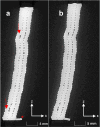Physico-mechanical characterization of 3D-printed PLGA for patient-specific resorbable implants in craniofacial surgery
- PMID: 40593251
- PMCID: PMC12214947
- DOI: 10.1038/s41598-025-07617-y
Physico-mechanical characterization of 3D-printed PLGA for patient-specific resorbable implants in craniofacial surgery
Abstract
Patient-specific implant (PSI) has optimized the management for a wide range of complex craniofacial deformity over the past years by increasing the accuracy of surgical procedures and lowering the operating time. In hypertelorism (HTO) surgery particularly, the orbital bone repositioning is nowadays guided by patient-specific bone fixation plates that are usually made from non-resorbable alloplastic material (e.g., titanium). Developing resorbable personalized plates could be a relevant alternative to overcome the well-known drawbacks of titanium plates such as infection, exposure or even the lack of bone growth which is detrimental in pediatric patients. This study investigated the mechanical and structural characteristics of poly(lactic-co-glycolic acid) (PLGA) PSI as resorbable materials for HTO surgery. We assessed the feasibility of printing PLGA PSI by Fused Deposition Modeling additive manufacturing (FDM). The geometrical and the mechanical properties of the 3D-printed device were compared with standard resorbable plates and analyzed after sterilization process (i.e., hydrogen peroxide gas plasma). The Young's modulus was greater than the standard resorbable plates while a decrease of 36% (p = 0.004) after the sterilization was observed. The sterilization also induced a plate deformation with an increase of 0.27 mm in Z-axis and a decrease of 0.8 mm in Y-axis due to annealing effect. Compared to the design, the PLGA PSI were successfully 3D-printed with a maximum deviation of 0.1 mm, making our custom-made plate promising for personalized craniofacial applications. Further investigations on the sterilization process must be considered in view of its mechanical and structural impact on resorbable PSI.
© 2025. The Author(s).
Conflict of interest statement
Declarations. Competing interests: The authors declare no competing interests.
Figures








Similar articles
-
Evaluation of graphene oxide-doped poly-lactic-co-glycolic acid (GO-PLGA) nanofiber absorbable plates and titanium plates for bone stability and healing in mandibular corpus fractures: An experimental study.J Plast Reconstr Aesthet Surg. 2024 May;92:79-86. doi: 10.1016/j.bjps.2024.02.063. Epub 2024 Feb 28. J Plast Reconstr Aesthet Surg. 2024. PMID: 38507862
-
Design, fabrication, andin vitroevaluation of a 3D printed, bio-absorbable PLA tibia bone implant with a novel lattice structure.Biomed Phys Eng Express. 2025 Aug 13;11(5). doi: 10.1088/2057-1976/adf750. Biomed Phys Eng Express. 2025. PMID: 40759139
-
Resorbable versus titanium plates for orthognathic surgery.Cochrane Database Syst Rev. 2017 Oct 4;10(10):CD006204. doi: 10.1002/14651858.CD006204.pub3. Cochrane Database Syst Rev. 2017. PMID: 28977689 Free PMC article.
-
Signs and symptoms to determine if a patient presenting in primary care or hospital outpatient settings has COVID-19.Cochrane Database Syst Rev. 2022 May 20;5(5):CD013665. doi: 10.1002/14651858.CD013665.pub3. Cochrane Database Syst Rev. 2022. PMID: 35593186 Free PMC article.
-
WITHDRAWN: Resorbable versus titanium plates for facial fractures.Cochrane Database Syst Rev. 2018 May 23;5(5):CD007158. doi: 10.1002/14651858.CD007158.pub3. Cochrane Database Syst Rev. 2018. PMID: 29797347 Free PMC article.
References
-
- Ahmad, W. et al. Fixation in maxillofacial Surgery—Past, present and future: A narrative review Article. FACE5, 126–132. 10.1177/27325016231221424 (2024).
-
- Batut, C., Paré, A., Kulker, D., Listrat, A. & Laure, B. How accurate is Computer-Assisted orbital hypertelorism surgery?? Comparison of the Three-Dimensional surgical planning with the postoperative outcomes. Facial Plast. Surg. Aesthet. Med.22, 433–440. 10.1089/fpsam.2020.0129 (2020). - PubMed
-
- Schlund, M., Paré, A., Joly, A. & Laure, B. Computer-assisted surgery in facial bipartition surgery. J. Maxillofac. Oral Surg.7610.1016/j.joms.2017.12.013 (2018). - PubMed
-
- Calluaud, G., Pare, A., Kulker, D., Listrat, A. & Laure, B. Computer-Assisted frontofacial monobloc advancement and facial bipartition for Pfeiffer syndrome: surgical technique. World Neurosurg.161, 97–102. 10.1016/j.wneu.2022.02.031 (2022). - PubMed
-
- Berryhill, W. E., Rimell, F. L., Ness, J., Marentette, L. & Haines, S. J. Fate of rigid fixation in pediatric craniofacial surgery. Otolaryngol. --head Neck Surg.121, 269–273. 10.1016/S0194-5998(99)70183-X (1999). - PubMed
MeSH terms
Substances
LinkOut - more resources
Full Text Sources
Miscellaneous

